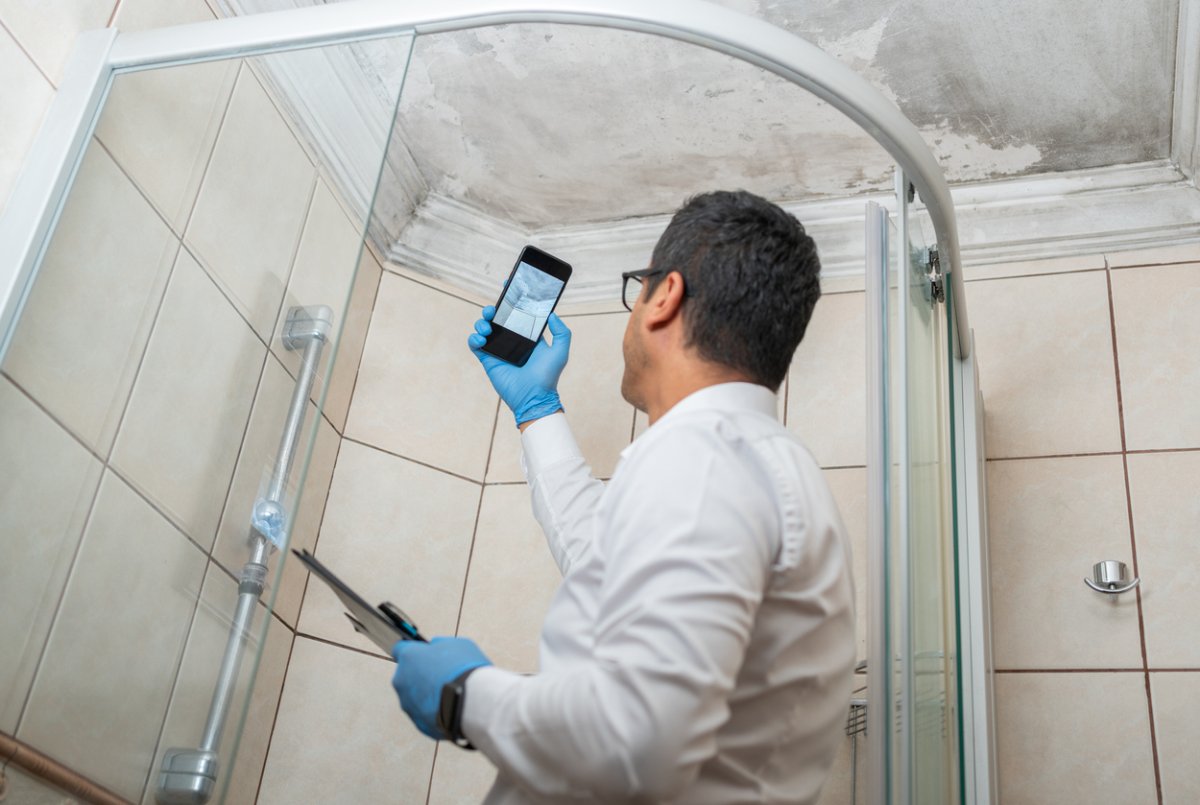

We may earn revenue from the products available on this page and participate in affiliate programs. Learn More ›
Highlights
- The typical cost range for a home mold inspection is $299 to $1,014, with a national average of $656.
- Cost factors for mold inspection include property size, mold type, test type, the location of the mold, and the geographic location of the property.
- Mold inspection is a good idea if a home has visible mold growth or a musty odor, cracked paint, or warped ceilings or if residents have ongoing coughs or sore throats. It’s also wise to schedule a mold inspection before a home sale, after a flood, or following water damage.
- While a homeowner or renter may be able to identify and deal with a small amount of mold themselves, professional inspectors can determine whether mold has spread to unseen parts of the home and whether it poses any danger to residents.
Any source of moisture in a home can lead to mold growth. Bathrooms, especially those without ventilation fans, are particularly susceptible with their constant steam and dry cycles. But kitchen vents, air ducts, and anywhere a pipe or appliance is slowly leaking are also potential mold locations. In those dark, moist areas, mold can grow quickly—and while some mold is just an annoyance or allergy concern, other molds can quickly become toxic. Therefore, at the first suggestion of a mold problem beyond a little at the edge of the tub caulk, homeowners will want to schedule mold inspection and testing. But how much is a mold inspection?
According to Angi and HomeAdvisor, homeowners can expect to pay between $299 and $1,014, and the national average cost for a professional mold inspection is $656. Costs tend to exceed the national average if the property being inspected is large, multiple types of tests are done, cost of living in the location is high, the mold is difficult to access, or the mold is an especially dangerous variety.
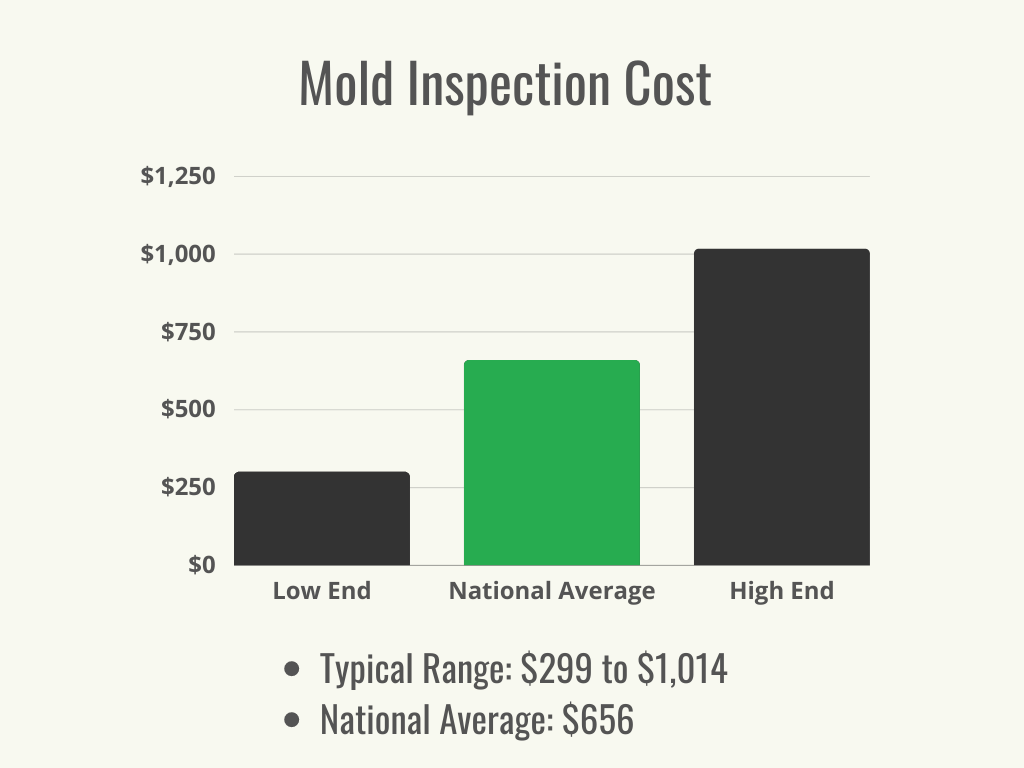
Mold Inspection vs. Mold Testing vs. Mold Remediation
There are three steps in the process to identify and eradicate mold growing in a home. It’s a good idea for homeowners to complete each of the three steps rather than jumping ahead; knowing what kind of mold is present will make it easier for homeowners to make decisions about how to get rid of it.
| Service | Cost |
| Mold inspection | $300 to $1,000 |
| Mold testing | $250 to $500 |
| Mold remediation | $1,150 to $3,400 |
Mold Inspection
A mold inspection is a good first step to take when a homeowner suspects a mold problem. A professional mold inspector (also called a certified industrial hygienist) will usually charge between $300 and $1,000 to complete a whole-house inspection, checking the spots where the mold is likely to be and determining which types of tests need to be run and where.A basic inspection takes about 2 hours, while a detailed inspection of the entire structure can take as long as 6 hours. The inspection may include one or more mold tests, costing between $50 and $300, which may be included in the overall charge for the inspection. The initial outlay for the inspection will allow the testing that follows to be targeted and will most likely save money in the long run.
Experts at New York Mold Specialists suggest considering a mold inspection “after you have experienced any type of flooding or water issue, if you smell a musty or unpleasant odor, if you are experiencing a leak that has been present for over 24 hours, or you notice stains on your furniture or building materials.”
Mold Testing
Mold inspection and testing costs are often charged together, but if the initial test indicates the presence of more dangerous types of mold, or if the inspector finds evidence that suggests there is more mold that requires remediation, additional testing may be required. Basic mold testing generally costs between $250 and $350, but that price range increases to $400 to $500 if the samples need to be sent to a lab for inspection. The cost for mold testing will typically include both the tests themselves and printed reports of the results from those tests.
Mold Remediation
Mold inspection and removal go hand in hand. Mold remediation is the process of removing mold and mold spores from a home. Costs for this will vary based on the magnitude of the mold growth, the type of mold, and the size of the home. However, in most cases mold remediation costs between $1,150 and $3,400. Remediation can be as simple as cleaning an area with a household mold killer like bleach or as complicated as removing chunks of drywall and discarding clothing and home decor fabrics; some molds really like to hang on and can’t be chemically removed.
Key Cost Factors
The answer to the question “How much does a mold inspection cost?” isn’t straightforward. Costs can vary by type of testing and the type of mold, as well as by the size of the property, the location of the mold, and the home’s geographic location.
Property Size and Type
The size of the space to be tested has a direct effect on the overall cost of the testing services for a simple reason: A larger space requires more samples over a longer period of time, and then those samples need to be individually tested. Testing in homes that are larger than 4,000 square feet may cost $700 to $1,000, whereas testing in smaller homes will cost $300 to $400.
If more than one type of mold turns up in the staining or culture labs, further testing will be required—and again, a larger space will have more sites to test. Commercial spaces tend to be more expensive to test for mold, but only because the spaces are larger and more varied, so additional sampling is necessary.
Mold Type
While basic inspection and testing is sufficient for most types of mold, there are certain types that are more dangerous than others and require immediate removal. As a result, if the homeowner suspects that these types of mold are present, or if an inspector notes any indicators that they are present, the testing process may be more expensive.
This applies to white mold mildew, which is a particular type of surface fungus that is often detected during mold inspections, but most particularly to black mold, which is the most dangerous type of spore to humans: Prolonged exposure can lead to serious illness and, in rare cases, death, so the testing procedures for suspected black mold are specific, expedited, and more costly.
Test Type
Before mold growth can be remediated, testing is usually necessary to determine how much mold is present and what kind of mold it is. While there are home tests available, more comprehensive and useful results can be garnered from professional testing. There are three primary types of sampling: swab testing, air cell testing, and specialty HVAC testing.
- Swab testing: A technician will collect a surface sample from an area that may have mold growth. This test is limited to the specific areas where mold is actively visible or strongly suspected and can be used to determine the type of mold growing in a particular area, but because it can’t be used to rule out mold growth in other areas of the home, it is often used in conjunction with air cell testing. The cost for swab testing is usually between $200 and $300.
- Air cell testing: A more complete picture of the mold presence in a home can be acquired through air cell testing. A technician will set up sampling equipment in several areas of the home and allow them to absorb air and spores for a set period of time. Then the air and spore samples are analyzed to average a total number of mold spores present in the home and determine what kind (or kinds) of mold is present to develop a more comprehensive plan. The average cost of air cell testing ranges from $250 to $350. More-advanced air tests may cost up to $700.
- HVAC mold testing: Mold that accumulates in the ductwork of a home’s HVAC system is particularly pernicious, because the system forces the spores out of the ductwork at a high velocity, spreading mold through additional ductwork and into the open areas of the house. Itchy eyes, sore throats, and respiratory ailments are common when there is mold in the HVAC system, even among residents who aren’t specifically allergic to mold, so in addition to duct-specific air cell testing, a technician will also use special tape to collect samples from the HVAC filters and inside the ducts. This adds approximately $50 to $75 to the cost of the air cell testing.
Once the samples have been collected, they must be processed at a lab that will assess the type and quantity of mold along with its rate of reproduction. Lab technicians establish these numbers using stain testing and mold cultures.
- Stain testing: After the mold samples are collected from swabs, tape, or air sampling, they are placed in plastic cassettes and treated with specialized stains. The stains make the spores easier to visualize through a microscope and allow technicians to identify the type of mold, the number of spores in the sample, and the patterns of growth. Costing an additional $150 on top of the sample collection, stain testing is critical to determining a remediation plan, as the type of mold will determine the best removal method.
- Mold cultures: This type of testing involves taking the samples collected in the home and placing them in a medium that will encourage the spores to grow. This will establish how quickly the mold is growing. If the mold doesn’t grow, the test indicates that the spores that have been collected are dead and there is no actively growing mold in the house. Cultures that grow aggressively indicate that the mold in the home is probably widespread and must be dealt with immediately to prevent further health consequences. Mold culturing rings up at about $50 in addition to the sample collection cost.
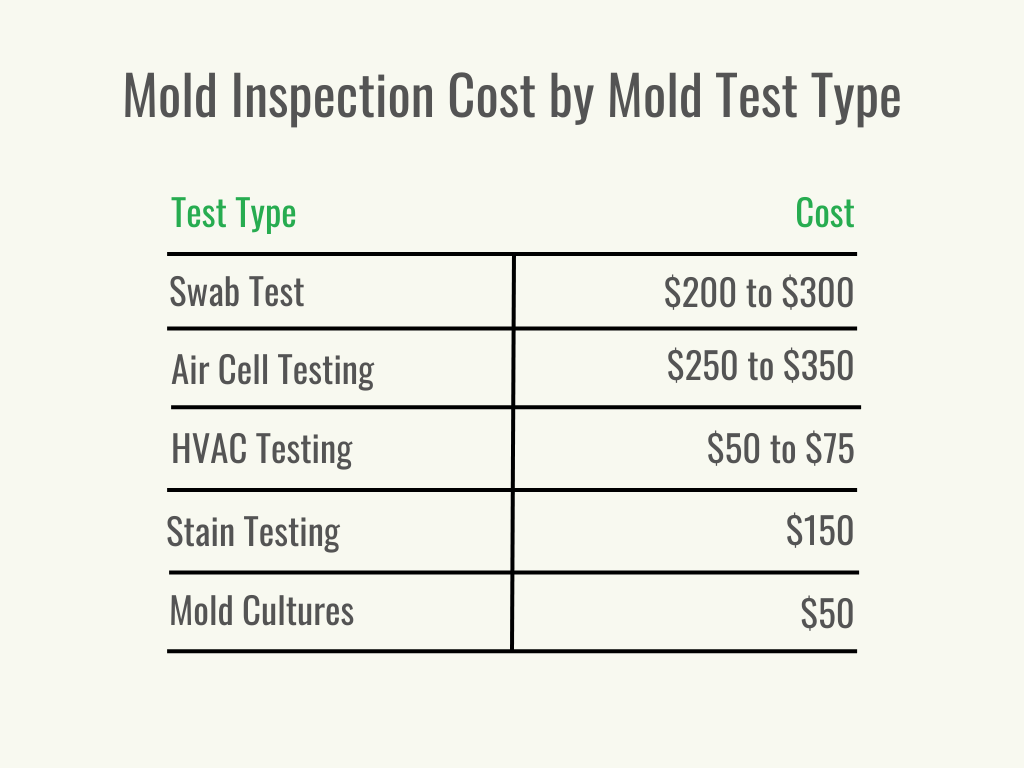
Mold Location and Accessibility
If mold is growing in a damp basement or in the attic near an ice dam or roof leak, it’s easy to access the potential mold colony to test. However, mold grows best in dark areas where dampness might be harder to see and testing is more difficult. Bathrooms and kitchens are notorious for mold growth behind walls, between tile and drywall, or in areas behind appliances or fixtures that are difficult to access.
In addition, when mold is widespread in a home (which will show up on an air cell test), it can be quite difficult to follow up with swab testing if there are no visible mold spores on the surfaces in the house. This is when mold testing can get really expensive: Excising pieces of drywall to access the back sides of walls for testing or hunting in the recesses of crawl spaces and moving appliances will add to labor costs, and gathering and testing a multitude of additional samples will drive up the cost as well, potentially in excess of $700.
Geographic Location
Due to variation in the cost of living in different cities, mold inspection costs can depend on where a homeowner lives. Typically, costs are highest in coastal cities, with homeowners in New York City paying $200 to $4,100. By contrast, residents of San Antonio, Texas, pay between $200 and $625 on average. Homeowners can look up “mold inspection near me” to get a sense of local prices.
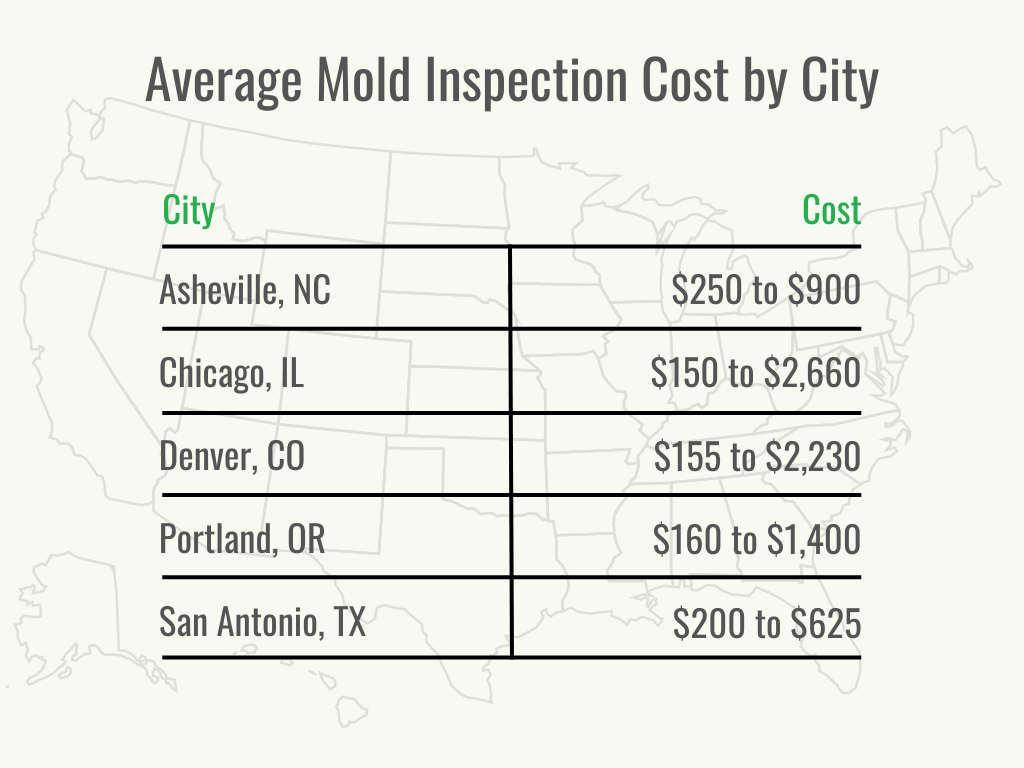
Additional Costs and Considerations
Mold can cause serious damage, so in addition to the cost for mold inspection and remediation, there may be additional costs associated with restoring the home back to its pre-mold state. Homeowners will want to consider the following when budgeting for mold inspection and remediation.
Mold Damage Repair
Even when mold itself has been removed, it can leave unsightly stains and damage on ceilings, floors, and walls. Drywall is the least costly to repair and typically costs $240. Costs for other materials may be higher, especially if they must be replaced rather than refinished or repaired.
Whole-House Dehumidifier Installation
Even if mold is successfully removed, it is sure to return if the conditions that created it remain unchanged. Many times, mold is caused by high levels of humidity in the home. Installing a whole-house dehumidifier can greatly reduce this problem. The system filters the air and converts excess moisture into condensation while releasing the treated air back into the home. Having a whole-home dehumidifier installed costs about $900.
Flooring Replacement
Mold can grow on most types of flooring, including carpet, hardwoods, and even the subfloor below. Since these materials are porous, they may need to be replaced in order to completely eradicate the mold. Costs for this project can vary depending on the area of flooring that needs to be replaced and the type of flooring material. For reference, carpet installation costs about $980.
Furniture Reupholstery
Mold can spread quickly on fabrics and upholstery, so furniture that has been affected will either need to be thrown out and replaced or reupholstered and restuffed. At a minimum, the labor and materials for this project will cost $750. Depending on the piece of furniture, it may be more cost-effective for the homeowner to opt for replacement over reupholstery.
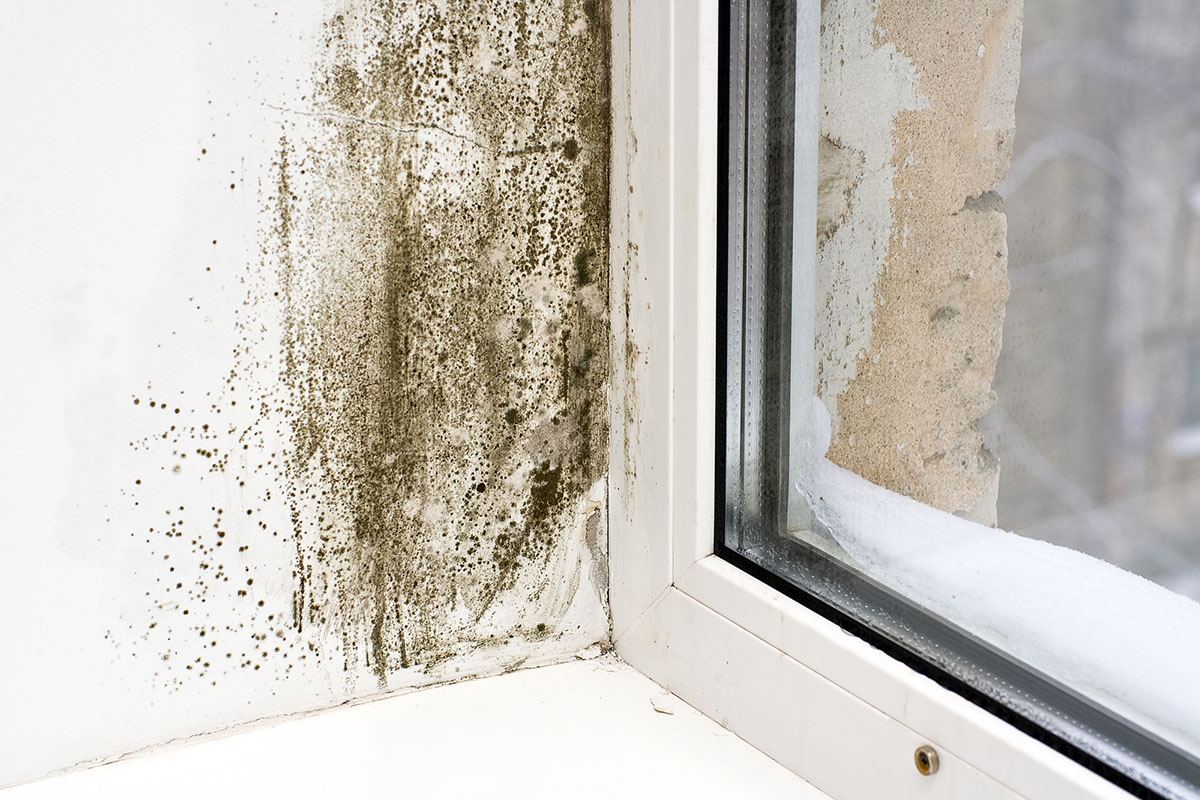
Types of Mold
Determining which specific mold is growing in the house is important in order to decide what type of remediation is necessary and how aggressive the remediation needs to be—some types are mild and inevitable, while others can be quite dangerous. The following are some of the most common types of mold and mildew inspections.
| Mold Type | Cost |
| Alternaria | $450 to $550 |
| Aspergillus | $450 to $550 and up |
| Aureobasidium | $450 to $550 |
| Chaetomium | $450 to $550 |
| Cladosporium | $450 to $550 |
| Fusarium | $600 to $800 |
| Penicillium | $500 to $600 |
| Serpula lacrymans | $500 to $600 |
| Stachybotrys chartarum | $600 to $800 and up |
| Trichoderma | $500 to $600 |
| Ulocladium | $500 to $600 |
Alternaria
Alternaria is an outdoor mold that grows best in the spring and summer, creeping inside on unsuspecting residents. It can cause significant damage to trees and plants, and it spreads rapidly in an explosive fashion, latching on to clothing, furniture, shoes, and then houseplants, carpet padding, and behind the walls—and it will continue to grow in homes with high humidity. Reactions can range from none to sneezing, throat irritation, and mild coughs. Because it is not difficult to find, it will usually be covered in a standard inspection cost. Alternaria inspection can cost between $450 and $550.
Aspergillus
Aspergillus is a class of mold that is made up of approximately 250 species. All aspergillus begins as a white fuzz, but then changes color as it grows (the colors include black, brown, green, and yellow, depending on the species). It can cause a serious respiratory infection called Aspergillosis, so it’s important to remove the mold and treat the infection promptly. In most cases, this kind of mold inspection will cost $450 to $550 or more.
Aureobasidium
Aureobasidium is a pink or black mold that most often appears on surfaces like painted or wallpapered walls. It’s a good idea to avoid contact with aureobasidium, as doing so can lead to infections in the eyes, nails, or skin. Aureobasidium inspection costs between $450 and $550.
Chaetomium
Chaetomium is an especially dangerous kind of mold that contains carcinogens and has been linked to brain infections. Chaetomium can be identified as a fuzzy light-colored mold that turns green or blue as it matures. It costs an average of $450 to $550 to inspect for chaetomium.
Cladosporium
This type of mold grows most aggressively in damp basements, bathrooms, and in HVAC systems. While it’s not an irritant to all residents, some may experience allergy symptoms or potentially a severe allergic reaction. Because it grows in areas that are fairly straightforward to access and test, cladosporium isn’t likely to incur additional inspection or test fees, thus costing $450 to $550.
Fusarium
Homeowners who have recently undergone a water leak will want to have their homes inspected for fusarium. This type of mold is highly toxic, and exposure to it can even cause blindness and scarring. Because of the danger associated with this type of mold, a mold inspection company may charge between $600 and $800 for this type of inspection.
Penicillium
This is a fast-spreading type of mold that is usually visible and identifiable by its blue-green velvet appearance. Penicillium (which was used to create the penicillin family of antibiotics) can cause an allergic reaction in some people, but it does require a substantial amount of water to grow. Therefore, it most frequently occurs in areas where significant water damage has occurred and the homeowner is already looking for mold and is less likely to grow stealthily in moderately damp areas. Penicillium inspection costs around $500 to $600.
Serpula Lacrymans
Serpular lacrymans is unique in that it is more dangerous to wood than to people. It is often the kind of mold present when materials are affected by dry rot. This type of mold can be found on wood, masonry, plaster, and mortar. Homeowners can expect to pay $500 to $600 for a serpula lacrymans inspection.
Stachybotrys Chartarum
Proliferating with astounding ease and speed on gypsum board, drywall, fiberboard, and paper, this dreaded mold is commonly referred to as black mold and requires immediate removal. It grows well in areas that have experienced flooding or major leaks, but also in areas that are subjected to high condensation and humidity, as it requires moisture to stay alive. Particularly dangerous to babies and young children, along with those with lung or respiratory problems, black mold can cause infection and even lung hemorrhage with sustained exposure. After identifying black mold, it’s a good idea for the homeowner to have a specialist to complete testing and coordinate removal to avoid spreading the mold to other locations. For this reason, a black mold inspection will be more expensive than other molds at $600 to $800 and up.
Trichoderma
Trichoderma is common in nature on soil and plants, but once it’s in a home it tends to grow in HVAC systems and on fabric and upholstery. Exposure to trichoderma can cause symptoms similar to seasonal allergy symptoms. This kind of mold inspection costs $500 to $600.
Ulocladium
Another mold that grows where significant water damage has occurred, ulocladium is a dark mold that grows on hard surfaces such as paper, paint, and wood, as well as softer textiles. It appears most frequently in basements and kitchens where a prolonged water exposure has occurred. Often, homeowners who find mold on their window sills will find that they have an ulocladium problem. While it is not terribly dangerous in and of itself—some residents may experience a hay fever-like response—the conditions in which it grows are also favorable to the more dangerous black mold, which is similar in appearance. Ulocladium testing will cost between $500 and $600.

Do I need mold inspection?
Sometimes mold makes its presence known: It helpfully appears in an area where dampness has allowed it to take hold. On other occasions, it’s hidden, and homeowners have to make their best guess based on a series of clues. There are also several key times to examine a home for mold.
Visible Mold Growth
If mold growth is visible, this may be a lucky sign that it has been caught early. Growth can appear as a spray of gray mold on a ceiling or wall, brownish football-shaped dots, or a persistent damp or discolored spot on a wall or wallpaper. In addition, the thin line of black or dark gray working its way across a line of grout or tile edge is also an indicator of mold. On the other hand, where there is visible mold—especially if there’s quite a lot—chances are there’s more that is hidden, and it’s time to call in some assistance.
Musty Odor
For homeowners who aren’t sure what mold smells like, a vaguely musty scent that’s slightly sour and slightly dusty is a good indication that there are more mold spores in the air than normal. Especially in homes with older HVAC systems, this olfactory clue should alert homeowners to the possibility of mold if an obvious source for the smell can’t be located elsewhere. The smell can settle into carpets, upholstery, and curtains, so the source may be an old air conditioning duct, but the growth can be present anywhere the air from that duct has touched.
Persistent Cough or Sore Throat
When the residents of a home begin to suffer from chronic allergy symptoms—especially if they’ve never experienced allergies before—a mold inspection is a solid choice. Mold spores can cause irritations and inflammation of the respiratory system, or flourish in the back of the throat, so these symptoms should not be ignored if they are out of pattern for the home’s residents.
Home Purchase or Sale
Whether buying or selling, it’s important to have a clear understanding of the mold levels in the home. Painting over mold to keep it hidden is not a viable solution. Sellers will want to remediate prior to putting the house on the market; taking care of the problem is a good-faith gesture, and a clean mold report will make it possible to honestly answer disclosure questions about mold and will look much better to potential buyers than having a home inspector’s test reveal a problem that then becomes part of negotiations. As a buyer, it’s important to know in order to decide whether to bargain down the home price to compensate for the remediation that will be needed down the road or require the seller to do so.
After a Flood
Any prolonged contact with water makes it more likely that the structures of the home have developed mold spores or growth. Because mold abatement is easier when the colony is smaller, testing after a flood makes sense to find and eradicate the mold before it even becomes visible.
After Water Damage
A small leak may not seem like a big deal, but if the surrounding areas have been damp or wet for a period of time, a mold inspection is a good plan. It’s better to inspect and treat the area where the leak made mold growth likely then to hunt for a larger outbreak later.
Cracked Paint and Rust
Like mold, rust requires moisture to develop. Its presence suggests that enough moisture has been in the area to cause damage—if the rust can grow, so can mold. An inspection can catch the mold growth before it becomes obvious or spreads.
Warped Ceilings or Walls
Ceilings and walls don’t warp or slump on their own unless they’re structurally unsound, and the most likely cause for failure of drywall is moisture. Wet drywall can resolidify after it dries out, but a misshapen panel is a sure sign that enough moisture has been present to grow mold, so an inspection will identify mold in the wall itself or lurking behind it.
DIY vs. Hiring a Professional
Is it necessary to run out and hire a mold inspection service at the first sighting of a speck of mold in the bathtub? Probably not. A small area of visible mold can often be managed and removed by the homeowner. Homeowners can choose from the best mold removers on the market to remove mold from shower tiles, grout lines, and window seams. Vinegar kills mold too, and often costs less than commercial mold cleaners. And small amounts of mold in a window air conditioner can be removed by carefully cleaning the unit. Larger visible mold growth or growth in confined spaces such as attics and crawl spaces would benefit from the know-how of a professional.
Homeowners may see mold testing kits on sale at the store and be tempted to save money by testing for mold themselves. But a homeowner won’t know the best places to collect samples or how to interpret the results. This kind of mold detector cost is probably money better spent elsewhere. If the homeowner suspects mold, it’s worth them hiring a pro. A trained professional knows where to look for signs of mold growth, how to test the mold, and can explain the results and inform the customer what kills mold and how they recommend treating the issue.
The Environmental Protection Agency (EPA) recommends that mold inspection and sampling be conducted by a professional who is trained and familiar with the specifications outlined by the American Industrial Hygiene Association or similar professional organizations. Homeowners who are unsure of who to call for mold inspection can start by looking at the best mold removal companies that operate in their area.
How to Save Money
Often, mold inspection costs are not negotiable. However, there may be a few ways to get ahead of the problem in order to avoid going over budget.
- Don’t wait. The longer a mold problem goes unchecked, the more extensive an inspection will need to be.
- Shop around. The average cost of mold inspection is $656, but costs can vary by company. Get multiple quotes on mold inspection to find the best price.
- Use the same company for remediation. Homeowners who want to know how to get a free mold inspection will want to look for companies that waive inspection fees if they are hired for mold remediation after finding mold.
- Check your homeowners insurance. There is a slight chance that your homeowners insurance covers mold. Most policies cover the remediation of mold that has resulted from a covered peril, but it’s a good idea to check your policy for specifics.
- Skip the home test. While home mold tests are cheaper than professional inspection, they may not be worth purchasing, since a professional will need to perform their own tests before beginning remediation anyway.
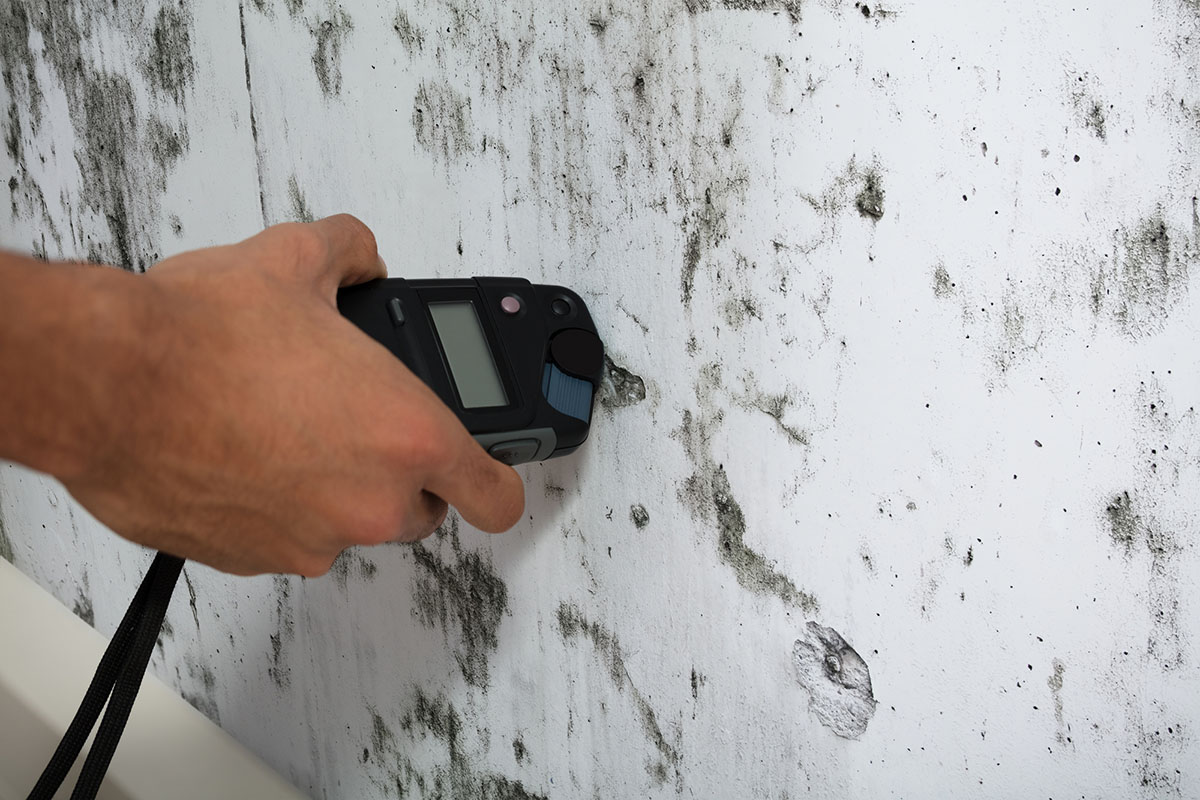
Questions to Ask a Pro
Mold inspection companies have their own categories of licensing and certification, most of them conferred by the Institute of Inspection Cleaning and Restoration Certification (IICRC). This organization publishes the standards for testing and remediating mold growth, among other things, in a publication called the S520. While mold inspectors are not legally bound to these standards, most reputable professionals will defer to them, so the first step before hiring a professional is to inquire about their knowledge of the S520 and their certifications. The following are some additional questions to ask after searching for a “mold inspection company near me”:
- Are you certified as a Water Restoration Technician (WRT) and/or Applied Microbial Remediation Technician (AMRT)?
- Are you a Certified Indoor Environmentalist (CIE)?
- Will you sample and test the mold, or simply remediate it?
- Which testing lab will you use?
- Do you also perform remediation, or would that be a separate professional?
- Will you perform the mold tests again after the remediation to make sure the remediation is successful?
- How can I be sure the mold won’t return after you’ve completed the work?
- Do you offer a period of warranty?
- Are there other services I need to prevent regrowth?
- What is the cost of the inspection, testing, and remediation?
- What unanticipated costs might crop up?
- Can you provide an itemized estimate in writing?
FAQs
Discovering (or suspecting) mold growth can be frightening from a health perspective and overwhelming because the extent of the problem is often unknown at first. As long as the mold inspection, testing, and remediation are handled as quickly as possible, mold growth can be halted and the home made safe. To make it easier for homeowners to settle on the best way to handle household mold, the following common questions and their answers can help.
The answer to this question depends on the extent of the mold growth. A small growth at the edge of the tub caulking can be taken care of with a bottle of mold cleaner. If you have a large growth of black mold, however, or significant spread through drywall, remediation can be significantly more expensive because of additional construction and whole-house cleaning processes that can raise the costs into the thousands of dollars. The cost to remediate that level of mold growth, however, is not a reason to ignore the problem—mold problems only get worse on their own, not better, and the potential health problems that may ensue can be dangerous.
The average cost for a mold test is about $656, but it can range from $299 to $1,014 depending on the size and complexity of the space. Some mold mitigation companies may offer free testing if you contract to use their services for remediation, which may be worth it if you are pretty certain that you have a problem.
DIY mold testing kits can be purchased at a home improvement store for $40 or less, but they won’t necessarily provide useful or accurate results. The best way to test for mold in your home is to contact a professional mold inspector who can more effectively test your home and assess the results of the testing for you.
If the testing reveals significant mold growth, the average cost of proper remediation will range from $1,150 to $3,400. This is a wide range because the extent of the mold growth and damage; remediation could be as simple as a deep professional cleaning with mold-killing products or as complex as wall and ceiling removal as well as replacement and plumbing repair.
HomeAdvisor, Angi, Fixr
